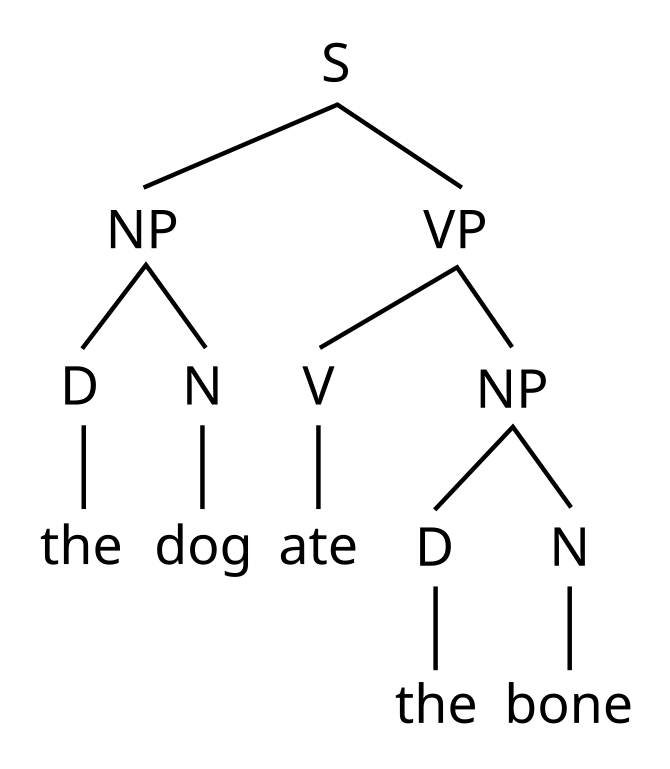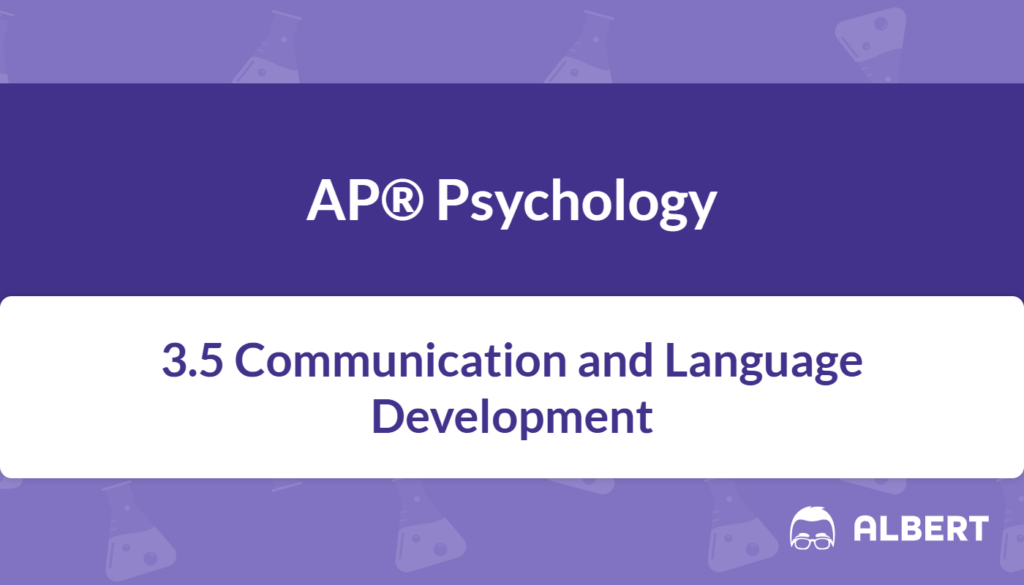Language and communication are essential parts of daily life. They influence how individuals think, learn, and interact with the world. Therefore, a strong grasp of language and communication development can improve both academic performance and social relationships. In psychology, understanding these concepts helps explain human behavior and mental processes, including how ideas are formed and shared.
This guide provides an overview of language as a system of arbitrary symbols, as well as the rules that shape and govern it. It also explains how language develops in humans over time, with an emphasis on important stages such as cooing and babbling. Finally, it highlights cross-cultural communication and common language-learning errors. These topics align with AP® Psychology standards 3.5.A and 3.5.B, offering a foundation in language and communication development.
What We Review
What Is Language?
Definition of Language
Language involves a mutually agreed-upon system of symbols that people use to communicate ideas. The symbols in language are usually words. However, these words have no direct relationship to the ideas or objects they represent, so they are called arbitrary symbols. Language has several important parts:
- Phonemes: The smallest units of sound (e.g., the “b” sound in “bat”).
- Morphemes: The smallest units of meaning (e.g., “un-” in “unhappy”).
- Semantics: The study of how meaning is conveyed by words and sentences.
- Grammar: A set of rules that dictate how words can be arranged.
- Syntax: The rules that organize words within sentences to make sense.
Example: Language as a Game
Imagine a game where each player has the same set of cards. Each card represents a word or a sound. To communicate meaning, players must follow rules about how to arrange these cards. Step by step, it might look like this:
- Select specific “cards” or words (phonemes and morphemes).
- Arrange them using agreed-upon rules (syntax).
- Share a complete idea that the other players understand (semantics).
This setup highlights the creativity of language: one can combine a small set of sounds into countless sentences, just as players in a game can shuffle and swap cards in numerous ways.
Key Components of Language and Communication
Components Overview
Language and communication rely on:
- Phonology: The organization of sounds in a language.
- Morphology: How words are formed and structured from smaller units (morphemes).
- Syntax: How words are combined to form meaningful phrases and sentences.
- Semantics: How meaning is interpreted from words and sentences.
These components work together to create a shared system that supports clear communication.

The Role of Grammar and Syntax
Grammar and syntax form the backbone of any language. Grammar rules can specify how words change form (e.g., adding “-ed” to show past tense). Syntax determines the order of words. Without proper syntax, a sentence can become confusing or lose meaning. Therefore, understanding grammar helps individuals put ideas into a coherent structure.
Example: Sentence Structure
Consider the simple sentence, “Cats chase mice.” Here is a step-by-step approach to see syntax in action:
- Identify the subject: “Cats.”
- Place the verb or action: “chase.”
- Attach the object receiving the action: “mice.”
Following these steps shows how subjects, verbs, and objects form a clear statement. Changing the word order to “Mice chase cats” changes the entire meaning.
Language Development in Humans
Stages of Language Development
According to AP® Psychology content, language development in humans occurs through distinct stages:
- Cooing: Infants produce long vowel-like sounds, such as “ooo” and “aah.”
- Babbling: Infants begin experimenting with consonant-vowel patterns, such as “baba.”
- One-Word Stage: Children start using single words, like “dog” or “juice,” to express whole ideas.
- Telegraphic Speech: Short phrases or sentences appear, often missing smaller words (e.g., “Want cookie”).
These stages highlight how language skills gradually become more complex over time.
Example: From Cooing to Telegraphic Speech
Observe a child’s progression in language use:
- At around 2 months: Producing drawn-out vowel sounds (“cooing”).
- At around 6 months: Practicing repeated syllables, such as “dada” (babbling).
- By the first birthday: Using single meaningful words like “ball.”
- By around 18–24 months: Combining two words, such as “Mommy go,” which represents telegraphic speech.
Step by step, infants refine their speech and expand their vocabularies, illustrating a steady increase in complexity.
Cross-Cultural Communication
All cultures exhibit similar language development milestones, although each language has unique sounds and structures. Additionally, people worldwide use nonverbal gestures, such as pointing or nodding, to help convey meaning. These gestures can be universal or vary slightly by culture. However, the pattern of learning phonemes, advancing to words, and forming sentences remains remarkably consistent across humanity.
Example: Universal Gestures
Compare two children from different countries who use the following steps:
- Both children first point to objects they want.
- Both children babble in ways unique to their languages.
- Both children combine words into short phrases around the same age.
Despite different cultures or languages, these developmental patterns appear universal, reinforcing that language development has common foundations.
Common Errors in Language Development
Overgeneralization of Language Rules
When children are learning a language, they tend to apply grammatical rules too broadly. This is overgeneralization. For example, adding “-ed” to form the past tense is correct for most English verbs (e.g., “played”). However, irregular verbs like “go” do not follow that pattern, so “went” is correct, not “goed.”
Example: Irregular Verbs
Imagine a child learning to speak. Step by step, the process might look like this:
- The child understands the rule for past tense (“add -ed”).
- The child says, “I goed to the store.”
- A caregiver corrects the mistake and models the irregular form: “I went to the store.”
- Over time, the child recognizes the exceptions to the rule and stops overgeneralizing.
Communication Development Milestones
Overview of Milestones
Communication development milestones mark age-related benchmarks in speech and language. They include:
- Reacting to voices and sounds in infancy.
- Babbling and experimenting with different sounds.
- Speaking single words.
- Forming simple sentences.
- Using complex sentences and following multi-step instructions.
These milestones help parents, educators, and healthcare professionals track a child’s progress and identify when additional support might be necessary.
Example: Early Childhood Timeline
A simplified timeline might look like this:
- 0–3 months: Responding to sounds and showing interest in faces.
- 6–9 months: Babbling and imitating basic tones.
- 12–18 months: Saying one or more meaningful words and pointing to objects.
- 2–3 years: Combining words into short sentences (telegraphic speech).
- 3–4 years: Using full sentences and a growing vocabulary.
Each step reveals growing linguistic and communication abilities.
Practical Applications of Language and Communication
Real-World Impact
Language and communication development influence academic success, social interaction, and career opportunities. It is much easier to convey ideas effectively when grammar, vocabulary, and social cues are well understood. Furthermore, educators who recognize different stages of language development can tailor teaching methods to meet students’ needs.
Example: Effective Communication in School
Imagine a student giving a presentation in class. The process highlights multiple steps:
- Gathering and organizing ideas into a logical sequence.
- Using clear language to explain complicated points.
- Adapting tone and volume based on the audience’s reaction.
- Employing body language, such as facial expressions and gestures, to support the spoken words.
Following these steps helps the student engage the audience and accurately share ideas, resulting in better comprehension and feedback.
Quick Reference Chart: Key Vocabulary
Below is a table that summarizes important terms related to language and communication development.
| Term | Definition |
| Language | A mutually agreed-upon system of arbitrary symbols used for communication. |
| Communication | The transmission of information or ideas between individuals. |
| Phonemes | The smallest unit of sound in a language that can distinguish words. |
| Morphemes | The smallest units of meaning in a language. |
| Semantics | The study of meaning in language. |
| Syntax | The structure of sentences and the rules governing word order. |
| Cooing | Early stage of language development characterized by the production of vowel-like sounds. |
| Babbling | The stage where infants begin to produce repetitive consonant-vowel combinations. |
| Telegraphic Speech | Speech that contains only essential words, similar to a telegram. |
| Overgeneralization | When a child applies regular grammatical rules to irregular cases (e.g., “runned” instead of “ran”). |
Conclusion
In summary, language is a rule-governed system of arbitrary symbols that can express infinite ideas. Understanding its components—phonemes, morphemes, semantics, grammar, and syntax—unlocks insights into how people communicate and learn. Furthermore, language development in humans follows patterns seen across cultures, demonstrating both universal qualities and culturally specific elements.
Ideas about communication development milestones and the phenomenon of children’s overgeneralization also shed light on normal learning processes. Mastering these topics offers practical advantages, including clearer expression, better academic performance, and richer social connections. These foundations reveal how language and communication development shape behavior and mental processes.
Sharpen Your Skills for AP® Psychology
Are you preparing for the AP® Psychology test? We’ve got you covered! Try our review articles designed to help you confidently tackle real-world AP® Psychology problems. You’ll find everything you need to succeed, from quick tips to detailed strategies. Start exploring now!
- What is Cognitive Development: AP® Psychology Review
- Social Emotional Development: AP® Psychology Review
- Classical Conditioning Psychology: AP® Psychology Review
Need help preparing for your AP® Psychology exam?
Albert has hundreds of AP® Psychology practice questions, free response, and full-length practice tests to try out.








